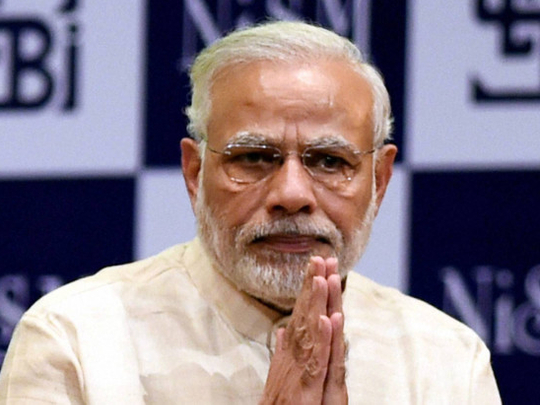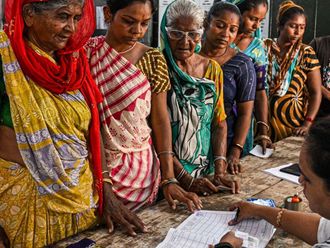
Indian Prime Minister Narendra Modi may hope to ride out the demonetisation storm because his opponents lack credibility at the national level, apart from being divided, and because of the extraordinary patience of the ordinary people in accepting their inconvenience. Furthermore, the fact that the people have retained their faith in the prime minister — until now — is evident from the series of election victories notched up by the Bharatiya Janata Party (BJP) in the municipal polls in Maharashtra, Gujarat, Rajasthan and Chandigarh.
True, the Trinamool Congress (TMC), which is perhaps Modi’s most trenchant critic, has also won several elections in its political hinterland of West Bengal, showing how the areas of influence of the various parties have become firmly demarcated. But Modi’s political clout is undoubtedly spread over a larger area.
Modi’s real test, however, will be in the Uttar Pradesh (UP) assembly elections next year. More than the polls in Punjab, Uttarakhand, Goa and Manipur, which are likely to be held at the same time, the outcome in UP will demonstrate how the BJP’s vikas purush (man of development) is faring half-way through his tenure.
The test is all the more important because demonetisation is a part of the kind of economic reforms that Modi wants to introduce. Since his “sabka saath, sabka vikas” (with all, progress for all) project of development for all hasn’t quite taken off, at least where employment generation is concerned, he is depending on his ability to curb the parallel economy and introduce a cashless system to help him cross the Rubicon of the next general elections.
In this respect, UP has always played a major part in indicating the popular mood if only because it is a heartland state. Having lost Bihar, which is also in the Hindi-speaking “cow belt”, Modi cannot afford to lose UP as well.
Even if he cannot replicate his sterling performance of 2014, when the BJP won 71 of the 80 parliamentary seats in the state, and its partner, Apna Dal won two, the two allies have to remain well ahead of their two major competitors: Ruling Samajwadi Party (SP) and Bahujan Samaj Party.
Some time ago, the family feud in the SP between Chief Minister Akhilesh Yadav and his uncle, Shivpal Singh Yadav, appeared to give the BJP the edge. But the fratricidal squabbles have subsided for the time being, presumably because the SP supremo, Mulayam Singh Yadav (the chief minister’s father and Shivpal’s elder brother) realised that the party was shooting itself in the foot because of internal bickerings.
Having first sided with Shivpal, Mulayam has since been playing a largely neutral role with a tilt towards Akhilesh, probably because of the realisation that the personable, 43-year-old Akhilesh has a far better image than his uncle with his suspected patronage of the rowdies who constitute the party’s cadres.
Being pro-development, like most present-day young Indian political leaders, Akhilesh has been vigorously rolling out various growth-oriented schemes to make up for the lost time when he was involved in his tiffs with the elders in the family.
Modi, therefore, will be wary of the fact that the SP is no longer a pushover as he thought during its internecine battles and when he was being lauded for the army’s surgical strikes on the bases of the terrorists across the Line of Control in Jammu and Kashmir. Moreover, if there is an electoral alliance between the SP and Congress in UP, then the challenge for the BJP will become even more formidable because of a rerun of the Muslim-Yadav voter combination for which Bihar was once known. The BJP’s disadvantage is that it doesn’t have an ally apart from the tiny Apna Dal. Nor does it have a chief ministerial candidate. Its only asset is Modi, but he is no longer what he was in 2014. To make the BJP’s presence felt in UP, his demonetisation gambit has to take off, especially after the 50-day time limit to exchange banned Rs 500 and Rs 1,000 tender ends on Friday.
But if the queues remain long, Modi will have a major challenge on his hands. As it is, Bihar Chief Minister Nitish Kumar has said that he will take a relook at his pro-Modi position on demonetisation after the 50-day deadline is over. Laloo Prasad Yadav, the former Bihar chief minister and Rashtriya Janata Dal (RJD) chief, has already said he will side with Modi’s opponents even before the end of the December 30 deadline. That will leave only Odisha Chief Minister Naveen Patnaik on Modi’s side. There is little doubt that where the aspirational younger generation is concerned, Modi has greater traction than either the two Bihar stalwarts or Mamata Banerjee, TMC supremo and Chief Minister of West Bengal, because of the continuing belief in Modi’s ability to boost the economy. But the problem for the BJP in UP is that unlike the Janata Dal-United, RJD or TMC leaders, Akhilesh has a greater appeal among the youth because of his forward-looking image.
If it is going to be a Modi vs Akhilesh battle, then it could be hugely politically damaging for the prime minister if the BJP loses in UP.
— IANS
Amulya Ganguli is a political analyst.









